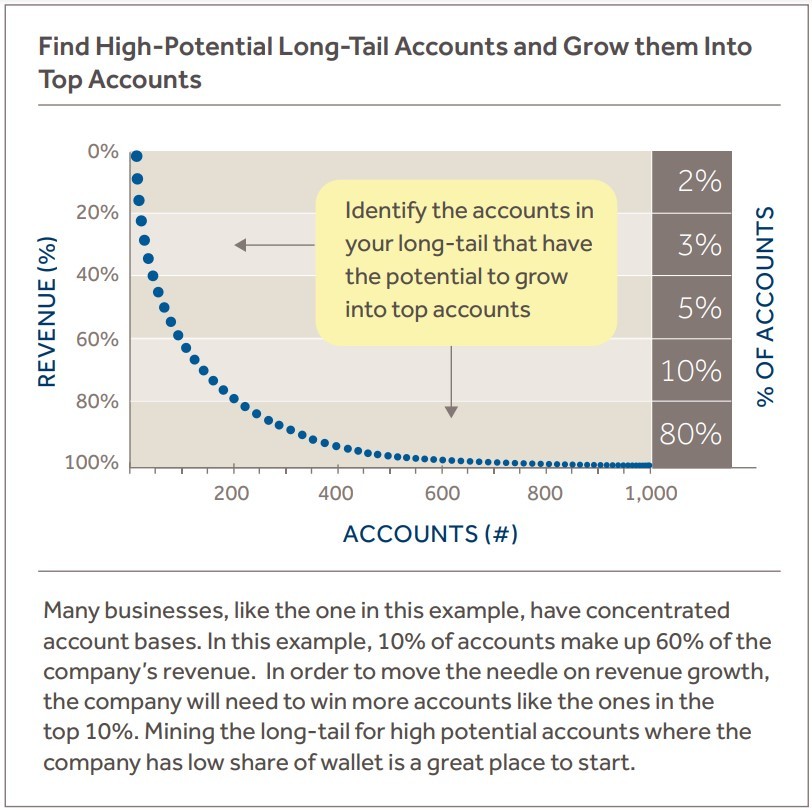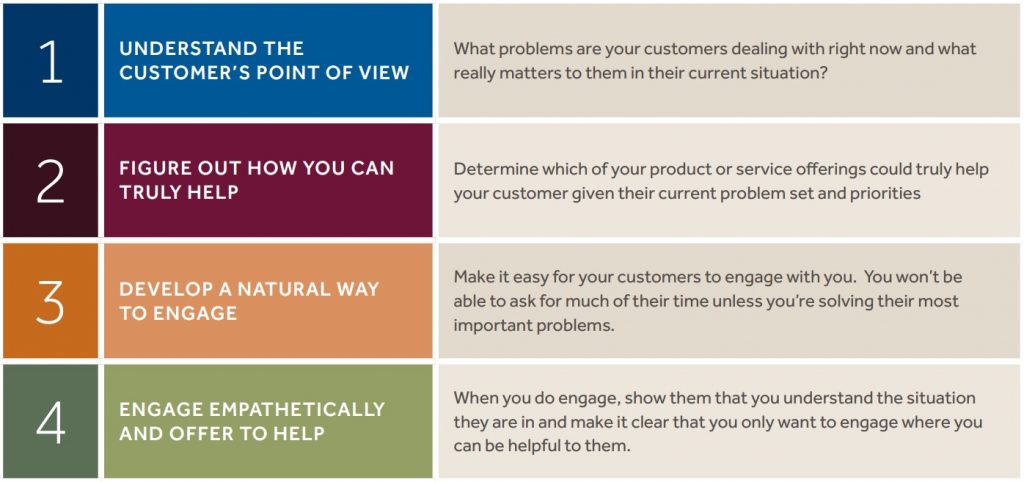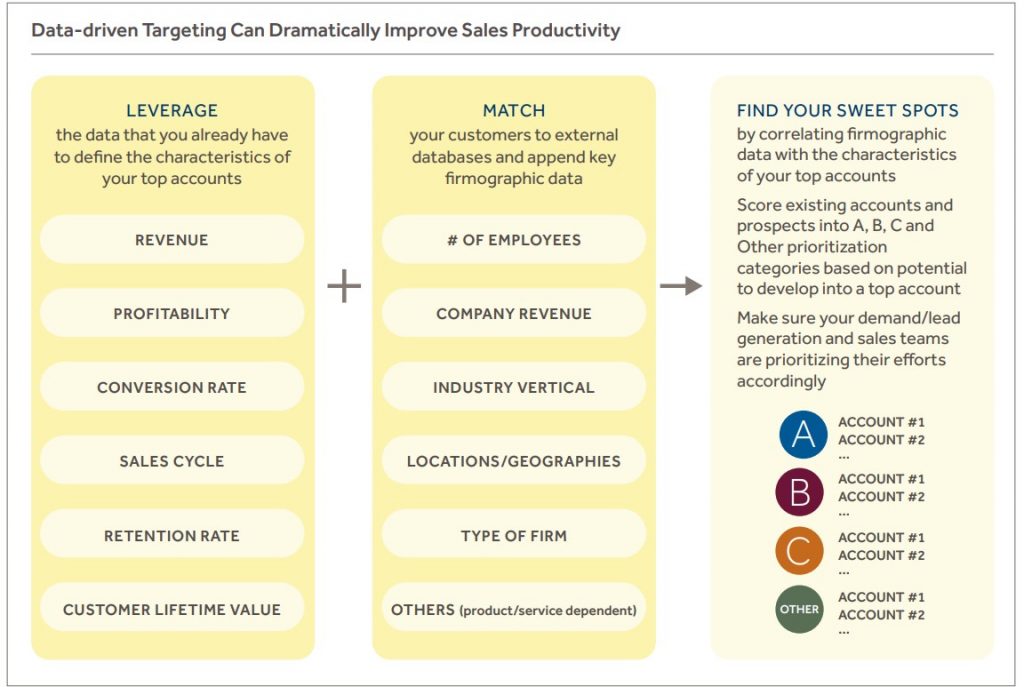Driving Revenue Growth in a Downturn
In a crisis or downturn, it’s easy for sales and marketing teams to get distracted by the turmoil around them. Instead of figuring out which products and services are still relevant, identifying the parts of the market that remain open, and developing sales plays that will work in the current environment, commercial teams often take their eye off the ball. With equally distracted prospects and customers, and financial plans and quotas out of reach, companies can find their entire commercial function hunkered down trying to ride out the crisis, making already poor revenue performance even worse.
As we described in our recent article, Climbing Back Up the Revenue LadderTM, world-class commercial functions take a different approach, moving fast to develop a plan to get their revenue back and seizing the market downturn as an opportunity to build a stronger and more efficient commercial function for the future. The key is to quickly align your sales
and marketing teams around a well-defined set of revenue growth opportunities and a pragmatic set of initiatives designed to capture them.
In our work with clients to develop these plans since the downturn began, we have focused on three types of opportunities and their associated tactics and actions:
- Find Opportunities to Win Now: Identify a set of customer and prospect opportunities that can be won right now and mobilize resources against them.
- Don’t Let the Crisis Go to Waste: The challenging market environment will present its own set of new opportunities. Make sure your team has identified them and is ready to adapt and capture them.
- Prepare to Win in the Recovery: A slow market creates an opportunity to address longer-term capability improvements and make the changes needed to reach for high performance during the recovery.
As you build your plan, you can select the initiatives that best fit your company’s circumstances and create a program that will instill a sense of urgency, keep the team focused and build positive momentum as you start your climb.
Table of Contents
Find Opportunities to Win Now
You likely have a number of opportunities to win right now with your existing customers and prospects. Some are already in your pipeline or were put on hold over the last few months and should be picked back up. If your sales team looks hard and in the right places, it will likely uncover many less-obvious potential wins. Move quickly to ensure your sales team has identified all of these opportunities and is pursuing them with the right approach and level of focus. Consider the following tactics:
Double down on winning a share of your wallet with your existing customers
Your largest near-term opportunity is often to cross-sell, up-sell, and increase your share of your wallet with existing customers. For your top existing customers, your sales team should know exactly which portion of their overall spend you currently have, which portion you don’t, and who you’re competing with. Consider running a series of workshops with your front-line sales managers and top sales reps to identify high-potential opportunities and establish an action-oriented account planning program to drive the right selling activities in these accounts.

You also likely have a number of small, “long-tail” accounts with the potential to be as large and profitable as your best accounts. You can leverage firmographic data (employee count, revenue, industry vertical) and customer data (revenue, profitability, conversion rate, sales cycle, retention rate) to identify high-potential long-tail accounts that look like your top customers. Include a review of these accounts during the workshop and ask your team to develop and execute account plans to grow these small accounts into top customers.
Prioritize segments that are performing well and adjust your product/service focus and messaging
Some of your priority market segments—and specific targets within those segments— will weather a crisis or downturn better than others. Your marketing and sales operations teams should move quickly to modify your segmentation approach and ensure your sales team is adjusting its efforts to focus on the right set of targets. Go deeper than broad categories (e.g., technology, healthcare, energy) to identify specific sub-segments that are still performing well (e.g., enterprise cybersecurity, networking, pharmaceuticals).
Your products and services will be similarly affected. Some offerings can become completely irrelevant or the market for them can completely shut down while other products or services in your portfolio will continue to resonate or even become particularly timely. Your product and marketing teams must understand these dynamics and arm your sales team with the right messaging. Sales leaders must ensure that sellers are shifting their product/service focus.
Use price as a strategic weapon
Widespread discounting to drive wins during a downturn is rarely the right approach as it risks resetting customer and market perceptions of the price and value of your product or service. You could end up trading your ability to maintain and increase prices within your existing customer base for relatively minor short-term wins. You also risk setting off a downward spiral with competitors quickly matching or even undercutting your lower pricing.
However, in select situations where you have the opportunity to win a foothold through an initial deal at a discounted price and then further penetrate the account or increase
prices in a meaningful way over time, consider using a low initial price or a one-time (e.g., for the first year) discount to secure the initial win and the opportunity to expand or increase pricing later. The key here is to be targeted. Focus on opportunities where the discounted price will make the difference and where there is potential for significant upside.
Similarly, for some products and services, you can consider free trial offers or establishing a freemium pricing model in cases where later expansion is likely. Finally, consider offering growth-based rebates or other promotions to incentivize existing customers to increase their spending. It’s important to structure these programs so that they only pay out for growth and cover their own costs.
Bring in the cavalry (the executive team)
A crisis or downturn calls for an all-hands-on-deck approach to selling. Too few companies sufficiently leverage their executive teams to drive wins with prospects and existing customers. At a minimum, just the presence of your CFO, CIO, head of the customer service, or CHRO will send a clear message to your prospect or customer that their account is extremely important to your company and that they have a direct line to your C-Suite if they need it. Beyond their presence and the message it sends, executive team members can help push sales teams’ thinking around account strategy and planning, ensuring the right questions are being asked, the right stakeholders are being engaged, the optimal process is being followed, and the team is setting itself up for success. In its highest possible form, executive alignment involves all members of the executive team leveraging their personal networks, past experience, and market knowledge to generate new leads and opportunities and to help move deals through the sales process.
Don’t Let the Crisis Go to Waste
The turmoil and change that comes with an economic crisis create new opportunities, often in the form of a changing competitive landscape with weaker and leveraged players struggling. Have your commercial function ready to identify and capture these opportunities as the crisis unfolds. Consider the following tactics:
Reach out to your customers with practical offers to help
Customers are constantly bombarded with offers and the pace only picks up during a downturn. Cut through all this noise and establish yourself as a trusted partner by offering real, practical help through an empathetic sales process that clearly demonstrates an understanding of the difficult situations in which your customers and prospects find themselves.
For example, if you’re a software company and your customers are training new team members to use your product, how can your customer success team go above and beyond to help? If you’re selling a complex service, what knowledge capital will be relevant to the issues your customers are facing now? Offer to conduct a workshop to help them apply it to their model. If you’re an industrial manufacturer distributing a product that’s in high demand, how can you operate outside your normal processes to get the necessary product to customers faster than usual?
Keys to an Empathetic Sales Process

The key is to stay engaged with your customers and ensure they know you’re ready and willing to do whatever you can to help them in their time of need. It’s often the empathy and the offer of help that your customers will remember and inevitably some of these conversations will turn into business development opportunities. At the very least, you’ll continue to be top of mind the next time they’re looking for a solution.
Identify top sales talent already in the market or newly open to making a move
The economy and market environment were strong over the last ten years. Unemployment hit all-time lows and the market for high-quality sales talent was tighter than we have ever seen. Top sellers were earning big commissions and bonuses, making it very difficult to hire them away from competitors or from adjacent industries.
During a downturn, it suddenly becomes easier to find high-quality talent as revenue targets are revised downwards, layoffs and furloughs ensue, and top reps and managers become more open to making a move. It’s important to be in the market for this talent early and to build a pipeline. A top sales rep is often three or more times more productive than an average performer and they tend to ramp very quickly, so make sure you’re using your ROI lens and not your budget or cost reduction lens when considering this opportunity.
Pursue competitors’ accounts
Customers and prospects who are currently being served by competitors that are viewed as at-risk (e.g., leveraged and unstable or small and vulnerable) will be open to new options. Your leadership team needs to keep its ear to the ground to understand how the current environment is impacting your competitors. Your front-line managers and sales reps should be aware of which competitors serve which major customers, especially in situations where you both serve the same customer. Be ready to mobilize your team to target specific customer relationships when a competitor stumbles.
Make the changes you’ve been putting off
Structural changes to the commercial function are often postponed when sales are strong. The executive team is concerned that changes will distract front-line sales managers and sales reps, so key issues and opportunities for improvement go unaddressed. During periods of turmoil, you often have a window in which your teams expect change. Take advantage of the opportunity to implement changes without much resistance or additional disruption.
Prepare to Win in the Recovery
In the midst of a crisis or in the early months of an economic downturn, it can be difficult to focus on a recovery that feels a long way off. But the last five recessions have lasted an average of only 11 months. The recovery will likely be here sooner than you expect.
When it arrives, pent-up demand will be released and customers and prospects will finally move forward with buying decisions. Consider the following five actions to reach for high performance in the recovery:
Develop a data-driven targeting capability
Very few sales reps are skilled at determining which targets to focus their lead generation efforts on. Too frequently, we see sellers left to their own devices to figure out where to spend their time. While it’s possible to build a complex, predictive model that incorporates many different data points to prioritize targets, you can get most of the impact through a straightforward look-alike analysis incorporating basic firmographic data (employee count, revenue, and industry vertical at the four or six digit NAICS code level) and customer data (revenue, profitability, conversion rate, sales cycle, retention rate and customer lifetime value).

And if you’ve been forced to reduce your commercial spending and employ a leaner sales team, improving your targeting approach can enable your remaining sellers to fill the gap.
Optimize your go-to-market model
Commercial leadership teams have been hesitant to make significant changes to their go- to-market models over the last few years. For many companies, this has led to inefficiency (e.g., overinvesting in lower-productivity resources) and inconsistency (e.g., multiple models across territories, groups, or teams). Others have avoided making adjustments like moving to a hunter/farmer model, building out an inside sales group, or developing a robust lead generation process. Take this opportunity to strengthen your model and build a foundation for high performance in recovery.
Leverage your channel partners and develop new partnerships
Your channel partners are facing the same challenges within their businesses as you are and will be trying to figure out how to respond to the crisis. Help them to adjust the way they are positioning your products or services with their customers in the new environment, leveraging their renewed commercial efforts as a multiplier for your internal sales force. This is also a good time to identify potential new partners who have relationships with and direct access to your priority market segments and targets. Because everyone’s revenue plans are now up in the air, you will find some partners more willing to explore new relationships.
Align sales compensation
In a strong market, the compensation cost of sales (the percentage of revenue you pay out as compensation to sales reps) has a way of creeping up over time. It’s difficult to make changes because you want to keep the sales team focused on winning and avoid distracting them with changes to their compensation plans. But in a weak market requiring adjustments to revenue targets and quotas, it is often easier to optimize sales compensation plans.
As you make these adjustments, you don’t need to try to keep everyone “whole” as though the downturn hasn’t happened, but your best salespeople are typically highly motivated by their compensation opportunity, so you need to make sure they have a constant financial incentive to drive new wins. You can leverage SPIFs (sales performance incentive funds) tied to specific objectives in the short term if needed. In the long term, your compensation plan needs to incentivize the right behavior for each role within your go-to-market model.
Define and document sales best practices
Too few companies have clearly defined best practices for each of their selling roles. Some hold the view that sales are more art than science, so they just hire experienced salespeople expecting they’ll know what to do on their own. Others simply lack the time and resources to step back from day-to-day selling activities and break their sales process and other critical commercial activities down into discrete tasks and define the best practices for each. Any company that has a selling role at scale (more than 10 sellers executing the same role focused on different accounts) can significantly improve productivity for its middle and lower-performing reps by putting this sales training resource in place.
Measure Progress and Stay Close to the Team
As you determine the mix of initiatives, strategies, and tactics that are right for your plan to climb back up the revenue ladder, it’s important to consider the way you will measure progress and hold the team accountable for executing. Start by setting objectives for the team to achieve. Define success for each of the initiatives you’re undertaking and develop a set of simple, outcome-based metrics to measure progress. For example, if you’re pursuing a specific competitor’s accounts, track the number of opportunities and wins you’ve generated with the target accounts. Be sure to include leading indicators like activity and pipeline that allow you to measure progress early on. The right set of objectives and metrics will give the team something to pull towards together and generate positive momentum.
Remember, it’s critical to keep the team engaged in a challenging environment. Distractions can do further damage to your sales productivity. Consider managing your plan as a highly visible program as you climb back up the revenue ladder together. When you launch your program, be transparent about the thinking behind the initiatives and communicate the metrics you’ll use to track progress. Host weekly update meetings and develop regular reporting so that everyone can see the progress being made and layer this messaging during all-hands calls, team meetings, and one-on-ones. When done right, these types of programs can generate the momentum you need and instill an all-hands-on-deck ethos across your commercial teams.


